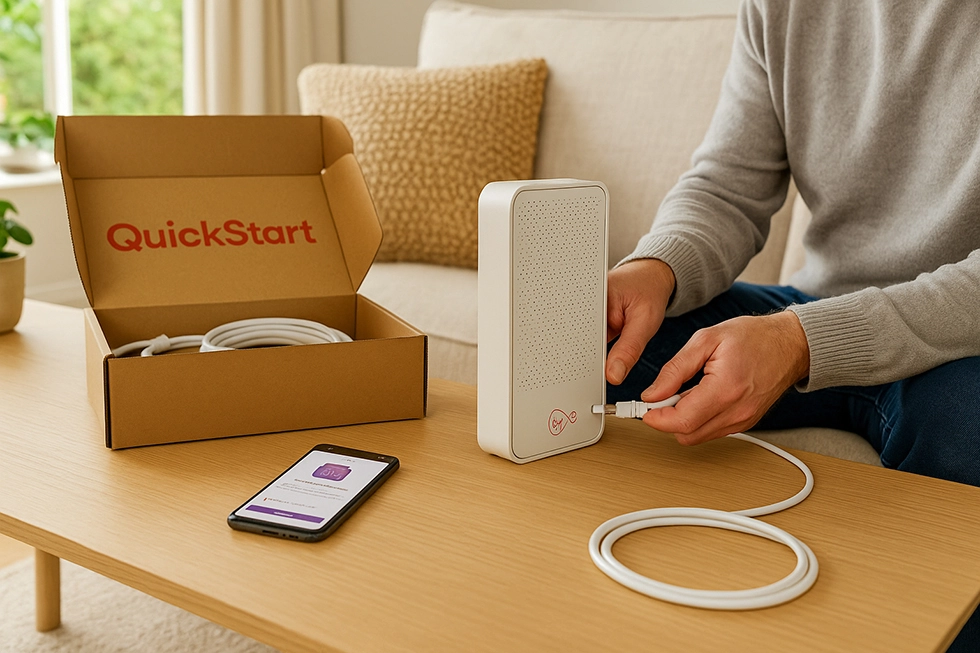Whole Home Wi-Fi and Mesh Broadband – Which UK Providers Offer
When people choose a broadband plan, they often focus on headline download speeds — 100 Mbps, 500 Mbps, even gigabit tiers. But what matters most in everyday use is whether those speeds actually reach your devices.
A fast fibre line is wasted if large parts of the house are stuck with a weak signal. That’s why Wi-Fi optimisation has become just as important as the line speed itself.
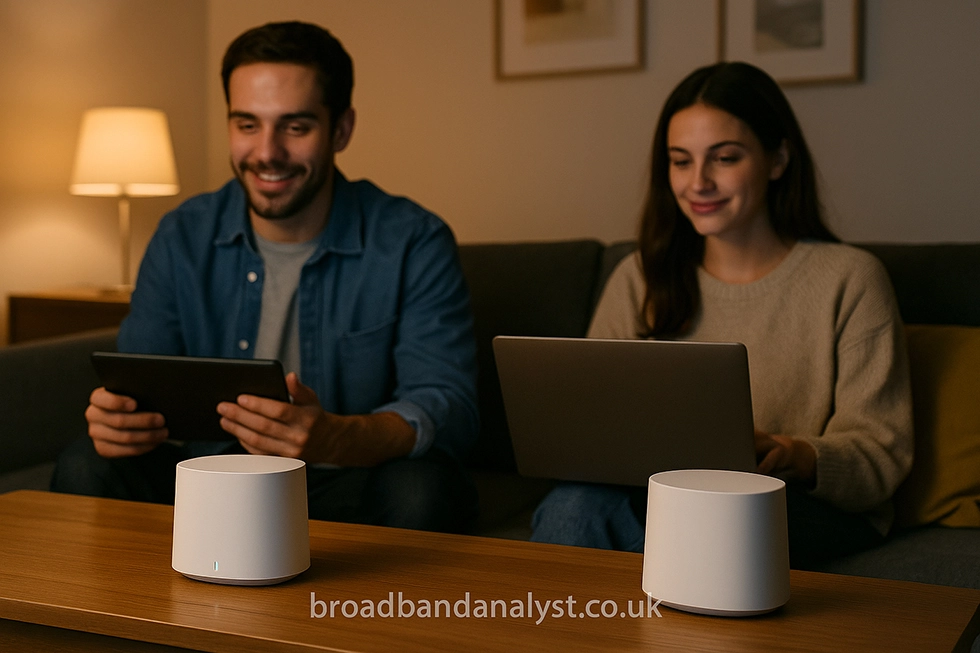
Most UK homes have some degree of patchy coverage. Thick walls, long hallways, loft conversions and garden offices can all block or weaken signals. Even with the latest routers, a single box in the hallway can’t always push a reliable connection to every corner. This is where whole-home Wi-Fi solutions come in. They extend coverage using mesh nodes or boosters so your devices can stay connected seamlessly as you move around the house. For streaming, video calls, gaming and smart home devices, this consistency is often more valuable than the theoretical maximum your broadband provider advertises.
What whole home Wi-Fi and every-room guarantees actually mean
Whole-home Wi-Fi is the umbrella term providers use for systems that spread wireless coverage evenly across a property. Instead of relying on one central router, you place multiple nodes — sometimes called discs, pods or boosters — around the home. These devices talk to each other and the main router, creating a mesh that passes your connection from one node to another. To you, it looks like a single Wi-Fi network, but the traffic is managed behind the scenes to keep speeds steady.
Many providers now attach guarantees to these packages. An “every-room guarantee” means the ISP promises a minimum speed in each room, not just at the router. For example, Virgin Media guarantees 30 Mbps in every room with WiFi Max, while EE goes further with 100 Mbps targets on its Smart WiFi Pro service. If the provider can’t meet that minimum even after sending out additional boosters, the guarantee usually entitles you to compensation — either a bill credit, free months of service, or in Vodafone’s case, the right to leave the contract without penalty.
These guarantees don’t mean you’ll always see your full line speed everywhere, but they do provide reassurance that coverage will be good enough for everyday tasks. They also put responsibility back on the provider to fix weak spots, rather than leaving you to buy and set up a third-party mesh on your own.
BT Complete Wi-Fi
BT’s Complete Wi-Fi is its branded whole home Wi-Fi add-on. It is built by combining BT’s Smart Hub (specifically Smart Hub 2) with one or more Wi-Fi Discs (mesh nodes) that extend coverage. Complete Wi-Fi is an add-on to a BT broadband plan. You pay a monthly fee for the add-on (on top of your broadband cost).
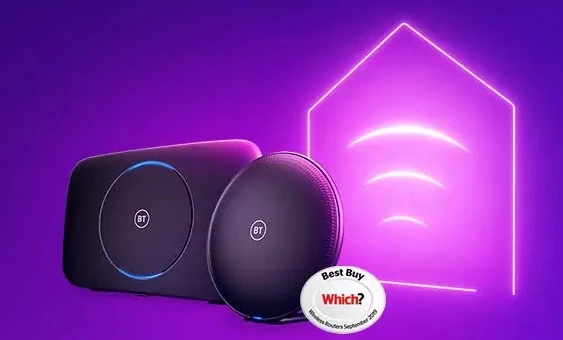
Complete Wi-Fi comes with a guarantee: BT promises that, if after adding up to three Wi-Fi Discs you still don’t have reliable Wi-Fi coverage in every room, you can claim £100 back.
The guarantee only applies when the Smart Hub 2 is connected to the broadband network (i.e. it must be functioning on BT’s network).
One caveat: the Wi-Fi Discs only work with Smart Hub 2 (i.e. older Smart Hub versions or other routers are incompatible)
Smart Hub 2
The Smart Hub 2 is the router unit that acts as the primary Wi-Fi source. It supports dual-band Wi-Fi (2.4 GHz and 5 GHz) and works with BT’s mesh system (the Discs). It has multiple Ethernet ports for wired connections.
The Discs communicate with the Smart Hub 2 and with each other, creating a mesh network. When placed optimally, devices seamlessly transition from one node to another.
An important capability of the system is that if one Wi-Fi Disc fails or is unreachable, your devices can reroute to another disc or the hub automatically.
The My BT app helps with setup: it suggests ideal disc placement and helps verify signal strength in each room.
Wi-Fi Discs
Each Wi-Fi Disc is a mesh node that extends the Smart Hub’s reach. They communicate intelligently to provide coverage in areas where the hub’s signal is weak or blocked.
Typical homes can often be covered by just one disc. But larger or complicated layouts may require two or three. The system supports up to three discs under the guarantee scheme.
Each disc is plug-in: you place it in a power socket, and it automatically joins the mesh network. You do not need to assign SSIDs or passwords anew.
If the system detects a disc is needed to improve coverage, you can request extra ones via the online troubleshooter or via BT support.
One caveat: extenders or older Wi-Fi boosters that may already be in the home should be removed, because they can interfere with the mesh’s performance.
Pros & Cons
Pros:
- Simple, managed solution: you don’t need to pick mesh hardware yourself.
- Seamless network: devices autoswitch between hub and discs.
- Backed by a guarantee (or £100 refund) if coverage fails after up to three discs.
- App support for setup and signal checks.
- BT handles the equipment and support.
Cons:
- The guarantee excludes external structures (gardens, sheds).
- You’re limited in the number of discs (max three under guarantee).
- Mesh performance still subject to home layout, interference, distances.
- If you cancel or downgrade, you must return the gear or face charges.
- Only works with Smart Hub 2; older routers are incompatible.
- You may not fully control finer technical settings (e.g. advanced mesh tuning).
Virgin Media – WiFi Max & WiFi Pods
Virgin Media’s WiFi Max is its whole home WiFi guarantee and mesh solution, bundled or as an add-on. It promises at least 30 Mb/s download speed in every room. If that fails after deploying up to three WiFi Pods, Virgin will credit £100 to your bill.
Virgin uses routers like Hub 3, Hub 4 or Hub 5 (depending on your package) that are mesh-capable. The mesh capability is built in, so the hub communicates with Pods seamlessly.

Pods are plug-in devices; you place each in a power socket roughly halfway between the hub and the dead zone to relay the signal. Pods may take up to 24 hours to fully stabilise in the mesh network after installation. Pods (mesh nodes) are supplied as needed: Virgin may send one pod initially, then up to two more (for a total of three) if speed tests in rooms reveal under-30 Mb/s performance. Virgin Media Connect mobile app helps you test WiFi in rooms, guide pod placement, and monitor performance.
WiFi Max is included at no extra cost for customers on Virgin’s highest tiers, including Gig1 broadband and Volt plans. For lower tiers, you can add WiFi Max for £8 a month.
Pros & cons
Pros:
- A very clear guarantee: 30 Mb/s in every room or £100 back
- Many customers on high tiers get WiFi Max included at no extra cost
- Managed solution: Virgin handles pods, diagnostics, app support
- The Connect app gives visibility into each room’s performance
- You can cancel the add-on if not satisfied (30-day notice)
Cons:
- The guarantee is modest relative to gigabit speeds (30 Mb/s is small fraction of total capacity)
- Mesh overhead may reduce peak speeds somewhat
- Pods must be placed within reach of the hub; poor placement hurts performance
- External structures and outbuildings are excluded
- The £100 credit is one-off, rather than ongoing compensation
- If a hub is old or underpowered, upgrading may be necessary before pods help
Sky – WiFi Max / Max Hub / Pods
Sky offers a WiFi add-on called “WiFi Max,” which gives you their Sky Max Hub (a WiFi 6 router) and “Max Pods” (mesh nodes) to boost coverage. Sky also advertises an “enhanced wall-to-wall WiFi guarantee” with minimum speeds per room depending on your plan.
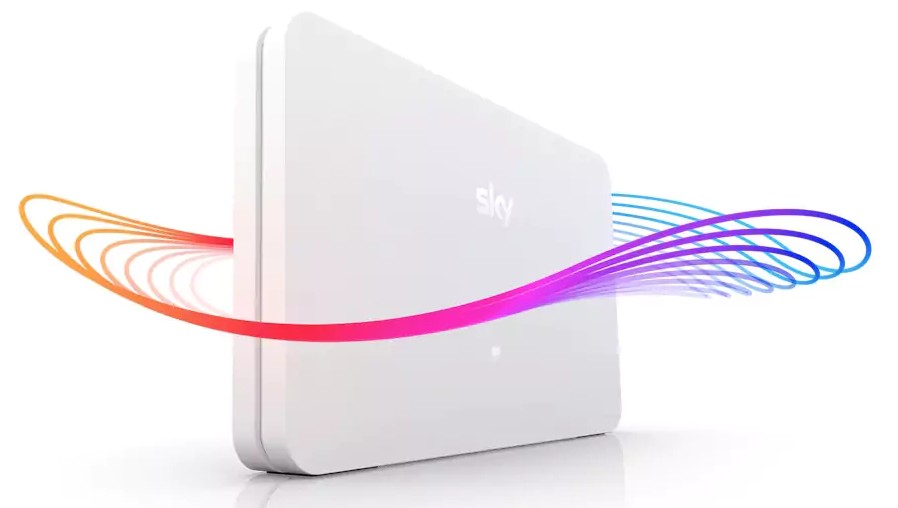
Without the add-on, Sky’s standard “Wall-to-Wall WiFi Guarantee” promises lower thresholds (e.g. 3 Mb/s in rooms) but with the Max option you get higher guarantees.
If your WiFi doesn’t reach every room to the guaranteed minimum, Sky may provide up to three Max Pods or send an engineer visit at no extra cost.
Sky’s add-on comes at about £4 extra per month (on top of your broadband cost).
If Sky cannot deliver the guaranteed speeds after deploying pods or performing visits, the compensation is one month’s free broadband (and WiFi Max subscription) rather than a cash credit.
Pros & cons
Pros:
- Relatively low add-on cost (£4/m)
- Upgraded router (Max Hub) with WiFi 6
- Provided pods help fill coverage gaps
- Enhanced guarantee compared to default plan
- Includes useful management features (profiles, scheduling, security)
- Some free engineer visits included
Cons:
- Guarantee is modest (10 Mb/s to 25 Mb/s), not comparable to gigabit speeds
- Compensation is free service, not cash
- Extra pods must be requested and may have delivery delay
- Pod performance may be limited if they are older WiFi 5 models, especially where hub is WiFi 6
- As always, building layout, walls, interference, pod placement matter heavily
- External outbuildings/gardens are excluded
- Guarantee only covers up to 12 rooms / 5 bedrooms
Vodafone – Super WiFi / Pro + Boosters / 4G Backup
Vodafone’s entry into managed whole-home WiFi comes via its Pro Broadband plans. Vodafone bundles these Pro features into their Pro 2 and Pro 3 plans. You don’t pay a separate add-on; the features are part of the higher tier package.
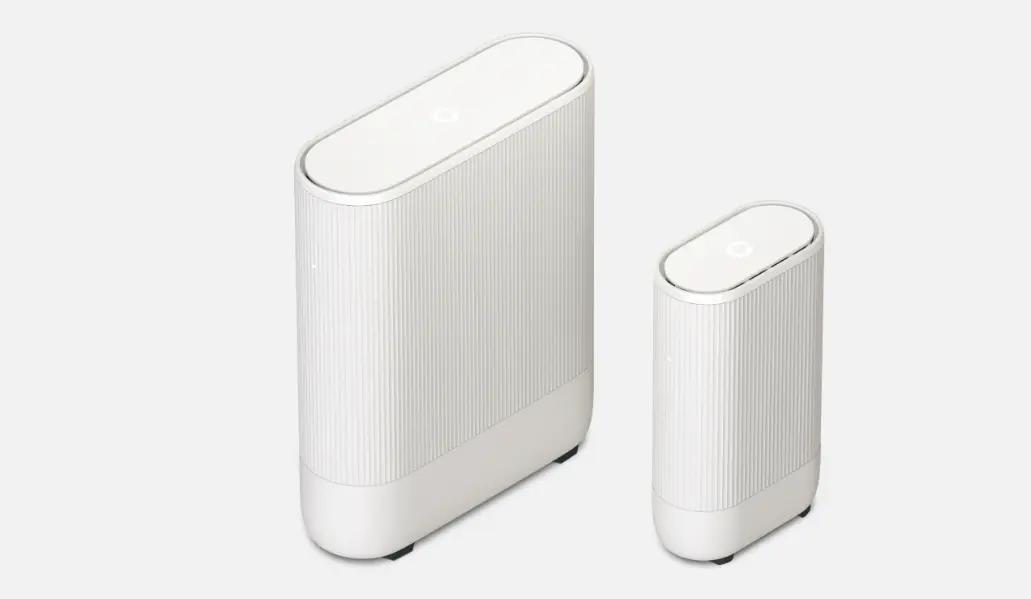
In these they bundle “Super WiFi” boosters (mesh nodes) and guarantee coverage, or allow customers to leave if it doesn’t deliver. Vodafone offers the latest Ultra Hub 7 (on Pro 3) and a previous hub on Pro 2, with built-in mesh capabilities.
Vodafone also includes 4G Broadband Back-up: a mobile data dongle or fallback that kicks in if your fixed broadband fails, so you stay connected for a limited allowance (100 GB per month).
They also offer Broadband Xperts support: dedicated monitoring and support for WiFi issues in the first 90 days.
Pros & cons
Pros:
- Integration: router + boosters + support + 4G backup all in one plan
- “Leave for free” guarantee gives customers confidence
- 4G backup ensures connectivity during broadband failures
- Xperts support helps mitigate WiFi issues in first months
- Modern WiFi standards (6E/7) in supported areas
- No separate add-on: features included in Pro plan
Cons:
- The guarantee is not a cash compensation; it’s an exit clause
- 4G fallback speeds depend heavily on mobile signal; may not match fixed broadband
- 100 GB monthly cap on 4G means it cannot serve as a full replacement for extended outages
- Performance through thick walls, large homes, or poor layout may still struggle
- If boosters are poorly placed, coverage holes remain
- In areas without full fibre, you don’t get top WiFi 7 gear
Community Fibre Broadband – Premium WiFi
Community Fibre Premium WiFi is an engineer-installed Linksys Velop mesh with one of the strongest in-home guarantees anywhere in the UK consumer market: if they can’t achieve at least 50 Mbps at the furthest point from the router inside your home, you won’t be charged for Premium WiFi and they’ll credit three months of broadband. That’s a high per-room target and a clear, wallet-friendly remedy.

It’s meant for larger or challenging London homes on Community Fibre’s full fibre network. The Linksys mesh is configured and tested by the installer, and they’ll optimise node placement to reach long corridors, loft rooms or extensions. If you’re in London and care about a high minimum in the out-of-the-way room, this is one of the best guarantees on offer
Hyperoptic – Total Wi-Fi
Hyperoptic’s Total Wi-Fi is a simple, add-on mesh extender called the Minihub. It pairs with the Hyperoptic router to enlarge coverage across the flat or house, and can be added at signup or later. Pricing is typically an add-on fee, with independent comparison sites listing £7 per month; check your address at checkout for current pricing. It’s not marketed as a formal “every-room speed guarantee,” but as a supported mesh extension.
The Minihub is a plug-in device supplied by Hyperoptic (Zyxel-based models are shown in their help centre). Setup is straightforward and guided; as with all mesh, node placement matters more than raw top speed. For very large or multi-floor properties, you may need more than one device or consider Ethernet backhaul.
Fibrus (NI) – Total Home Wi-Fi Guarantee
Fibrus builds its whole home wifi on Amazon eero. On Full Fibre 500 and above, you get multiple eero units included by default, and the Total Home Wi-Fi guarantee promises at least 10 Mbps in every eligible room. If they can’t deliver after troubleshooting, Fibrus supplies one more eero at no extra cost; documentation and price guides reiterate the 10 Mbps standard and the included hardware by tier.
This model suits larger Northern Ireland homes because you begin with two eeros on faster tiers, giving you a mesh from day one rather than adding it later if you encounter dead zones. As ever, the guarantee applies to in-dwelling rooms, not outbuildings.
YouFibre – YouMesh (Wi-Fi 7)
YouFibre now ships a Wi-Fi 7 hub as standard on residential plans, with optional YouMesh boosters that are also Wi-Fi 7. That immediately puts YouFibre among the most future-proof consumer setups, especially if you have lots of modern devices that can take advantage of 320 MHz channels and Multi-Link Operation. You can add more boosters on a monthly fee if you need to push coverage into lofts or extensions.
Practically, the hub plus a single YouMesh booster covers many three-bed homes; add more for three-storey or L-shaped layouts. YouFibre’s support articles include plain-English placement tips, and their customer guides reiterate that older devices still connect fine to Wi-Fi 7 hubs; they just won’t hit Wi-Fi 7 peak rates.
Zzoomm – Wi-Fi 7 hub and free in-home setup
Zzoomm includes a Wi-Fi 7 hub with residential services and provides free in-home Wi-Fi setup at installation. It’s not marketed as a numeric “every-room” guarantee, but it is one of the few ISPs that bundles Wi-Fi 7 hardware and an expert setup visit as standard value. That matters in older houses with thick internal walls where initial placement and channel planning save you a lot of grief later.
Support pages walk through router placement and connection options; if you’re wiring a garden office or an outbuilding, Zzoomm’s team will still optimise the main dwelling but may recommend separate cabling or point-to-point links beyond the base install scope.
Zen Internet – EveryRoom
Zen’s EveryRoom is a managed, FRITZ!Box-based mesh service designed to guarantee a usable Wi-Fi signal throughout homes up to 170 m². Zen deploys a FRITZ!Box router with one or more FRITZ! repeaters, and they own the optimisation end-to-end: survey, placement advice, and escalating to extra hardware if the footprint demands it. It’s a service and guarantee rather than a mere “booster” sale.
Two key selling points: the guarantee explicitly lists typical “eligible rooms” including integral garages and loft conversions, and it’s pitched as a supported outcome, not a DIY gamble. Pricing is available on Zen’s site (standard vs refurbished hardware options), making it one of the clearer, consumer-friendly propositions among ISPs in this space. Zen also documents hardware like the FRITZ!Box 7530 AX (Wi-Fi 6) for customers who want the technical detail.
Gigaclear – Smart WiFi Mesh
Gigaclear’s Smart WiFi is a Linksys-powered mesh that complements its rural full fibre. The nodes are Wi-Fi 6 capable and are managed via the Linksys app; the ISP offers clear setup guides for adding child nodes and optimising placement. Where promoted, Smart WiFi can be bundled or discounted with faster tiers, but the emphasis is on a supported mesh for long, sprawling rural homes.
Gigaclear Linksys” router comes with AC2200-class Wi-Fi, dual Gigabit Ethernet ports, and a quad-core processor. This is useful if you’re deciding between ISP-managed mesh versus a retail system; the Linksys ecosystem integrates perfectly with the Gigaclear hub.
Brsk – BetterWiFi
Brsk offers BetterWiFi add-on that guarantees a usable signal in every room and at least 10 Mb/s in homes up to 1,850 square feet. The guarantee explicitly lists which rooms count and excludes outbuildings. It’s one of the more transparent altnet offerings, with a home-size cap to set expectations. Pricing is transparent and can be added alongside symmetrical fibre plans up to 2 Gbps.
Because Brsk’s base service is symmetric and competitively priced, the BetterWiFi add-on is a sensible option if you want managed mesh with a published floor on in-room speed. For bigger properties above the size cap, you’ll either need extra nodes or a different approach such as Ethernet backhaul.
NOW Broadband – Wall-to-Wall Wi-Fi Guarantee
NOW’s broadband (powered by Sky) carries a simple promise: Wi-Fi in every room or your money back. It’s a consumer-friendly guarantee that mirrors Sky’s approach but keeps the headline message clean on its sales page. In effect, take a NOW broadband plan and, if you cannot get Wi-Fi coverage throughout your home after their optimisation steps, you can claim money back on that guarantee.
NOW uses Sky’s network, support tooling and router line-up. That means the experience broadly aligns with Sky’s default Wall-to-Wall Wi-Fi scheme, though NOW doesn’t publish all the speed thresholds in marketing copy like Sky’s “10–25 Mb/s per room” tiers. You still get parental controls via Broadband Buddy and the usual app/account tools to test and improve coverage before invoking the guarantee.
TalkTalk – Total Home Wi-Fi
TalkTalk’s Total Home Wi-Fi is a managed mesh add-on built around Amazon eero. The add-on is designed to eliminate dead zones by creating a single, seamless Wi-Fi network across your home. It’s available on full fibre and part-fibre tiers, costs £8 per month on most plans, and is included with Full Fibre 900 in some promos. You order it through TalkTalk; they supply an additional eero to pair with your main router and will send more if coverage still falls short.
What you get is a supported mesh rather than a DIY booster: TalkTalk guides placement, helps you add extra eeros, and troubleshoots interference. The help pages explicitly frame it as “reach every room, guaranteed”, and the service is meant to be an escalation path after you’ve tried channel tweaks and basic optimisation.
The practical “guarantee” target that appears in independent guides is 10 Mbps in each eligible room. If TalkTalk can’t achieve that after sending an engineer and extra kit, the remedy is to cancel the add-on without penalty rather than a cash credit. It’s a fair value add-on for smaller to medium homes that want a supported eero mesh without self-configuring a third-party system.
Hardware notes are straightforward: current TalkTalk eero units are Wi-Fi 6 capable, steer devices automatically, and are set up through the eero app; the newer Wi-Fi Hub 3 also supports Wi-Fi 6 and mesh features for busy homes. Just remember mesh hops reduce peak throughput; place nodes halfway to the problem rooms, not in the not-spot itself.
Plusnet
Plusnet doesn’t offer a branded whole home Wi-Fi guarantee or a managed mesh add-on. You get the Hub Two as standard, a dual-band Wi-Fi 5 router with 3× Gigabit LAN plus 1× Gigabit WAN. It’s reliable for modest footprints, but it isn’t Wi-Fi 6, so don’t expect top-end wireless on gigabit plans. Plusnet’s own help and community consistently advise customers to buy a third-party mesh if they need guaranteed room-by-room coverage.
Hub Two specs:
- Dual-band 2.4 GHz 3×3 802.11n and 5 GHz 4×4 802.11ac
- 3× GigE LAN, 1× GigE WAN
- Simple QR setup, WPS, and basic management via the hub UI
There’s no “every room” refund or credits; Plusnet’s performance guarantees are framed around wired line speeds. If you want a guarantee, you’ll need to pair Plusnet with a retail mesh kit (e.g., Deco, Orbi, eero) and accept that support for the mesh comes from the vendor, not Plusnet.
UK Whole Home Wi-Fi Comparison
| Provider | Features | Cost |
|---|---|---|
|
BT Router: Smart Hub 2 (Wi-Fi 5/AC) Mesh: BT Wi-Fi Discs |
Whole-home mesh with BT Discs Up to 3 discs (under guarantee process) Every-room coverage guarantee (£100 credit if unmet) My BT app placement/scan Halo/Hybrid Connect 4G backup (select tiers) |
Add-on; included with select Halo tiers Return on cancel/downgrade |
|
EE Router: Smart Hub Pro (Wi-Fi 7/BE) or Smart Hub (Wi-Fi 6) Mesh: Smart WiFi/Smart WiFi Pro boosters |
Tri-band Wi-Fi 7 (6/5/2.4 GHz) on Pro 320 MHz (6 GHz) / 160 MHz (5 GHz) channels 2.5 GbE WAN + 4× 2.5 GbE LAN (Pro) 100 Mb/s in every room (qualifying plans) Smart Hybrid Connect 4G failover (select plans) |
Included on top FTTP bundles Pro gear add-on on FF150+ (typ. ~£10/m) |
|
Virgin Media Router: Hub 3/4/5 (Wi-Fi 5/6) Mesh: WiFi Pods (Plume) |
WiFi Max programme Up to 3 Pods (managed) 30 Mb/s per-room guarantee (£100 credit) Intelligent WiFi + VM Connect app Included with Gig1/Gig2 and Volt (activate) |
£8/m add-on on lower tiers Included on select premium bundles |
|
Sky Router: Max Hub (Wi-Fi 6) Mesh: Max Pods |
WiFi Max add-on 10 Mb/s (Superfast) / 25 Mb/s (Ultrafast/Gigafast) room targets Up to 3 Pods + engineer optimisation App controls, parental profiles, security 1-month fee credit if guarantee not met | ~£4/m add-on |
|
Vodafone Router: Pro 2 (Wi-Fi 6E) / Pro 3 Ultra Hub 7 (Wi-Fi 7) Mesh: Super WiFi boosters |
Super WiFi coverage guarantee Leave-free if unmet (contract exit) 4G Broadband Back-up (100 GB/month) Broadband Xperts setup/monitor (first 90 days) Wi-Fi 7 hardware on Pro 3 FTTP areas |
Included with Pro/Xtra plans No separate add-on on Pro tiers |
|
TalkTalk Router: Wi-Fi Hub/Hub 3 (Wi-Fi 6) Mesh: Amazon eero (Wi-Fi 6) |
Total Home Wi-Fi (managed eero mesh) Practical target ~10 Mb/s per room eero app setup + TalkTalk support Engineer escalation if required |
£8/m add-on (varies by plan) Included on select FF900 promos |
|
NOW Broadband Router: NOW Hub (Sky platform) Mesh: Sky-aligned guarantee (no named pods) |
Wall-to-Wall Wi-Fi money-back guarantee Uses Sky network/tooling Coverage optimisation via support/app |
Included with NOW broadband Remedy = refund (per policy) |
|
Plusnet Router: Hub Two (Wi-Fi 5/AC) Mesh: none (DIY third-party advised) |
3× GigE LAN + 1× GigE WAN Dual-band 2.4/5 GHz (AC) No every-room guarantee Suggest retail mesh (Deco/eero/Orbi) if needed |
No ISP mesh add-on Retail mesh cost separate |
|
Zen Internet Router: FRITZ!Box 7530 AX (Wi-Fi 6) Mesh: FRITZ! Repeater(s) |
EveryRoom coverage guarantee Managed survey/placement Rooms incl. loft conversions/integral garage (policy) New or refurbished hardware options |
From ~£9/m (std) ~£6/m (refurb) for customers |
|
Community Fibre Router: CF-supplied (Wi-Fi 6) Mesh: Linksys Velop (engineer install) |
Premium WiFi guarantee ?50 Mb/s at furthest indoor point 3-month broadband credit if unmet London FTTP footprint only |
Premium WiFi add-on (price at checkout) Credit if target not met |
|
Hyperoptic Router: Hyperoptic hub (Wi-Fi 6 capable) Mesh: Total Wi-Fi Minihub extender |
Plug-in extender (managed) App-guided setup Focused on flats/MDUs No formal per-room Mbps guarantee | ~£7/m add-on (typical; check address) |
|
Fibrus (NI) Router: Fibrus hub (Wi-Fi 6) Mesh: Amazon eero (multi-unit on 500Mb+) |
Total Home Wi-Fi guarantee ?10 Mb/s per room target Extra eero provided if needed Multi-unit included on FF500+ |
Included on faster tiers Add-on on lower tiers (price guide) |
|
Gigaclear Router: Linksys-powered (AC2200 class) Mesh: Linksys Velop (Wi-Fi 6) |
Smart WiFi mesh ecosystem App management + node add-ons Rural FTTP focus, larger footprints Ethernet backhaul supported (best practice) |
Included/discounted on select tiers Otherwise add-on (check plan) |
|
brsk Router: brsk hub (Wi-Fi 6) Mesh: BetterWiFi nodes |
?10 Mb/s per room (home ?1,850 sq ft) Clear room eligibility policy Symmetric FTTP up to 2 Gbps Managed placement/optimisation | ~£10/m add-on |
|
YouFibre Router: Wi-Fi 7 Hub (standard) Mesh: YouMesh Wi-Fi 7 boosters |
320 MHz channels (6 GHz) + MLO Backward-compatible with Wi-Fi 5/6 Optional boosters for multi-storey homes App guidance + support docs |
Hub included Boosters monthly add-on |
|
Zzoomm Router: Wi-Fi 7 hub (standard) Mesh: setup advice; add nodes as needed |
Free in-home Wi-Fi setup at install Wi-Fi 7 router as standard Placement/channel optimisation guidance No numeric per-room guarantee |
Included hub Extra mesh hardware optional (retail/ISP) |
Key points across providers
Strongest guarantees
If you want the highest promised speeds, EE’s Smart WiFi Pro stands out with 100 Mbps in every room on its top full fibre plans. Community Fibre’s Premium WiFi is strong too, with a 50 Mbps target even in the furthest room. Virgin Media’s WiFi Max guarantee is lower at 30 Mbps, but they back it with a £100 credit if they can’t fix it.
Best included options
Some providers throw in whole-home WiFi on their faster packages. Virgin includes WiFi Max with Gig1, Gig2 and Volt bundles. Fibrus ships two eero units straight away on 500 Mb+ plans. YouFibre and Zzoomm go further by making Wi-Fi 7 hubs standard on all their fibre deals.
Support options
Compensation and support vary. Virgin and NOW offer money back or bill credits. Vodafone’s Pro plans let you leave without penalty if Super WiFi doesn’t work in your home. brsk sets a clear rule with its BetterWiFi add-on, promising 10 Mbps in every room up to a defined home size.
Conclusion
Whole home Wi-Fi is no longer an optional extra. It’s become a core part of what UK broadband providers deliver, making sure fast fibre speeds reach every corner of the house. The main difference between providers lies in how far their guarantees go, what hardware they include, and what remedies they offer if coverage falls short.
If you’re choosing between packages, look beyond the advertised download speed and check the Wi-Fi solution that comes with it. Whether it’s a high minimum Mbps guarantee, Wi-Fi 7 hardware, or a money-back promise, the best choice depends on the size and layout of your home and how many devices you want to keep connected.
